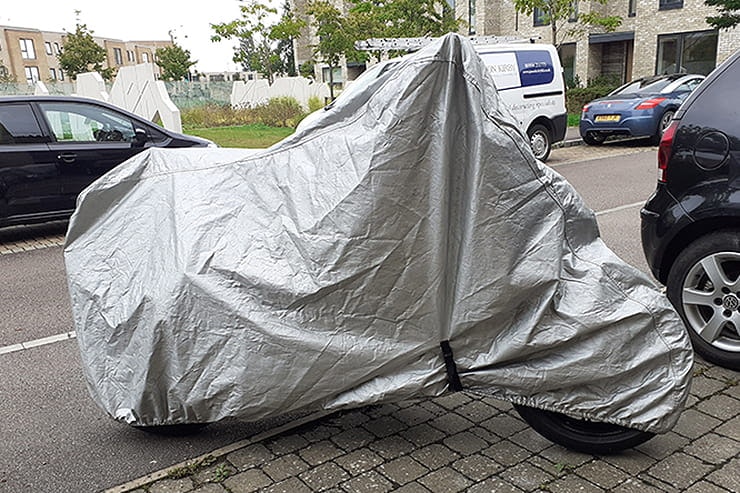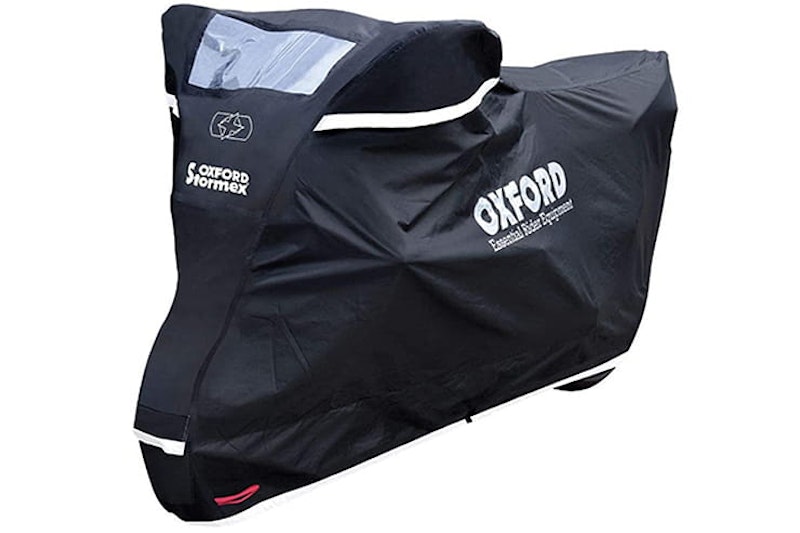If you have to keep your bike on the street then a decent cover is a no-brainer – not only will it keep off the rain and spray from passing traffic, but it will also prevent thieves (or their spotters) from identifying the bike as they drive by. Obviously, they could just stop and peer underneath, but most don’t bother.
Even if you’ve got a garage, a bike cover is still worth having for when you have to leave the bike in a city (where most thieves operate), or overnight, or just in terrible weather. And if you do any kind of DIY in your garage, you’ll need a cover to stop the bike getting coated in dust, grass clippings and paint splatters. A cover can also prevent scratches when a bicycle/rake/child falls on it.
There are dozens of covers available and it’s surprisingly easy to spend a fair wedge of cash on something unsuitable, so here’s a guide to choosing the right one.
DIY motorcycle covers
When you see the prices of covers (plenty are over £50) it might be tempting to use that piece of tarpaulin or plastic sheeting the builders left, but we wouldn’t recommend it. They create multiple problems.
Firstly, because they’re not the right shape, excess material can flap in the wind and damage paintwork.
Secondly, because they’re not vented, they will marinade your bike in condensation – it’s not as bad as leaving it out in the rain, but it’s not perfect.
And thirdly, you have to remember to let the bike cool down if you would prefer the plastic sheeting to remain a separate entity to the exhaust system. DIY covers are good at deterring thieves though – who in their right mind would wrap up their new S1000RR in an old tarpaulin?
Best outdoor motorcycle cover
Many things to consider here.
Make sure it’s waterproof. You could use an indoor cover if your only priority is theft prevention, but it won’t last long – the wind will flap it to shreds. Waterproof ones are far sturdier.
Check the fit is right for your bike (see below). Buying a massive cover for a small bike costs more and means all the excess fabric will flap in the wind, potentially damaging paintwork. Some covers have stretchy panels, which make for a better fit.
If you plan to leave the bike any longer than overnight, especially in winter, make sure the cover has ventilation to help stop condensation wreaking havoc.
Check it’s heat resistant around the exhaust – not just around the endcan, but along the underside where you might be able to strap the cover under the bike.
The lining should be soft to prevent it chafing paintwork.
A strap that goes under the bike’s belly helps ensure the cover can’t blow off. It helps keep all of the bike obscured too.
Non-UK readers might want to check if the cover will protect paintwork from extended exposure to sunshine.
Best heavy-duty motorcycle cover
If the cover will only be used outside your house (ie you can leave it at home), get the most heavyweight cover you can afford. These can cost £80 or so, but that’s a good value garage substitute. In fact, you could consider getting a cover with a metal frame that swings over the bike to create a tent – these start at around £120.
If you want to carry the cover with you then bulk comes into the equation. Some of the expensive heavyweight covers are impossible to roll-up any smaller than a big sleeping bag, so you’ll need a rack, topbox or generous pannier. This is where buying from a local shop rather than online can be useful, so you can gauge if it will be a total pain to lug about.
Indoor cover tips
The cheapest are just dust covers, which might be all you need. Heavier duty stretchy ones can prevent scratches as you brush past carrying the lawnmower. Don’t be tempted to use a non-ventilated outdoor cover, as condensation can build up and will slowly rust fasteners, banjo bolts etc.
What are half covers?
These cover the top half of the bike, keeping the seat and switchgear dry. If you’re not worried about security these can be a good option because they’re so much easier to carry round – they’ll fit in a smallish rucksack. They’re cheaper too and easy to put on.
Get the right fit
Ideally, buy a cover specific to your type of bike – there are covers for sportsbikes, adventure bikes and full-dress tourers and cruisers. If you’ve got a large capacity adventure bike be particularly careful because you’ll need a massive cover – even something that fits a Goldwing could leave the wheels exposed (which is a bad idea – see security). Plus, putting on an ill-fitting cover is annoyingly difficult. If you’ve got a topbox, check to see if there’s a cover with that taken into account, otherwise even an extra-large cover can come up short.
Security
For maximum protection, you want the entire bike covered – even the tyres. If it doesn’t pull down far enough, those Brembo monobloc calipers at the front or that 200-section tyre at the rear could be enough to persuade a thief to have a peek underneath. It’s also worth seeing if the cover has holes big enough to pass your security chain through. Check out some more expert bike security tips here.
How much to pay?
You can get unbranded covers on eBay for £10 that claim to be waterproof, but we can’t vouch for their quality. Branded outdoor covers (Oxford, R&G, Specialised, MotoGP) start at around £25, though there are big discounts available at online retailers such as Sportsbikeshop.co.uk. £50 will get you a good quality outdoor cover that should last for years. Branded indoor covers start at around £20. BikeSocial have tested Specialised covers before and rate them – there’s a discount on them via Bennetts Rewards.
Top motorcycle cover tips
If buying online, measure your bike carefully and include a topbox and panniers if you use them. Plenty of so-called XL covers won’t fit an adventure bike or tourer with a top box.
Don’t forget you might have to strap the cover to the bike – check how small it rolls up.
Mark the front and rear of your cover with a permanent marker. It saves putting the bloody thing on backwards and having to start all over again.
Don’t store it damp. Most won’t rot, but they’ll certainly niff.
Sounds obvious, but don’t put stickers on the cover that give away what bike is underneath.

